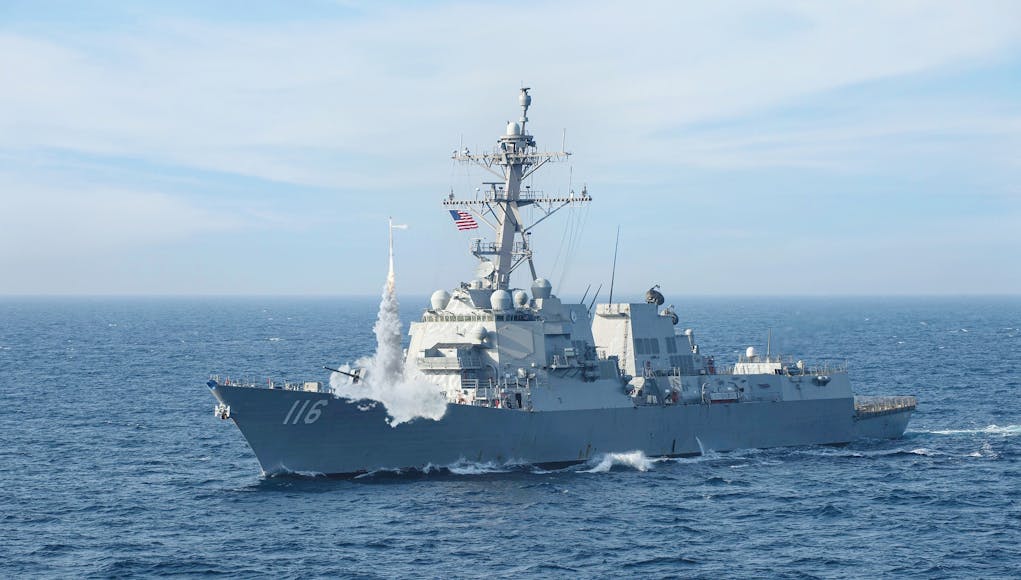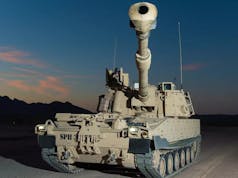Lockheed Martin successfully launched a PAC-3 Missile Segment Enhancement (MSE) interceptor from an MK-70 containerised launch platform to engage and destroy a cruise missile target in flight.
This test marks the first time PAC-3 MSE was launched in this configuration, utilising the Virtualised Aegis Weapon System to intercept a live target.
“This successful test showcases Lockheed Martin’s commitment to developing mission-focused, integrated technology to keep those who serve ahead of evolving threats,” said Tom Copeman, vice president of Strategy and Naval Programs at Lockheed Martin.
“These systems could deliver a proven, Integrated Air and Missile Defense (IAMD) capability with growing capacity to the U.S. to help defend against advanced, maneuverable threats.”
Lockheed Martin aims to enhance the IAMD capabilities of the U.S.’s most modern combat systems to defend against simultaneous advanced air, surface, and missile threats. The PAC-3 is designed to counter advanced threats, including tactical ballistic missiles, cruise missiles, hypersonic missiles, and aircraft.













If PAC3 is a “One shot one kill” missile like Aster this truly is a major upgrade for the Burkes.
There is no such thing as a “one shot one kill” interceptor.
PAC-3 is hit to kill, but so is the much longer ranged SM-3. It’s an apples to oranges comparison as SM-3 is an exoatmospheric weapon, but the USN already has hit-to-kill weapons.
PAC3 is an interesting issue for the USN, they don’t seem to be asking for it, LM is pushing it. But it does offer some advantages. It can address more stressing terminal BMD targets then the SM-6, but has dramatically less range in a normal air to air role, and PAC-3 cost looks similar to SM-6.
SM-6 is more versatile and can also attack surface targets. PAC-3 in it’s current guise can only be loaded one to a MK-41 cell, like the SM-6 (dual pack PAC-3 would need different control surfaces, meaning a new variant and more expense).
So while the PAC-3 is a better weapon for terminal BMD, it’s a one-trick pony, while SM-6 is far more versatile and costs the same.
PAC-3 has a much higher production rate, but SM-6 production will hit 300 per year in 2028.
Production rate aside, and given a similar cost, why would the USN want a less versatile, lower ranged missile for the same price to fill a MK-41 cell?
It will be interesting to see if the USN actually wants to buy the PAC-3. I suspect if LM makes a version that can fit two to a MK-41 cell the USN would be more bullish on it. More weapon choice is better, especially in a world with a lot of ballistic missiles to address, so integration of PAC-3 with naval systems is a win-win if the USN decides they want it.
According to LM, PAC-3 can be quad loaded (as per ESSM) in a strike length MK41 VLS. I think the main driver, has been the expenditure of missiles whilst patrolling the Red Sea. Plus the need to return to port to replenish.
I can see the logic, as the PAC 3 is a direct replacement for the latest SM-2. But instead of one SM-2 per cell, you can now have four PAC-3s. So if 20 SM-2s were loaded, you have now replaced them with 80 PAC-3s. Thereby allowing the ship to stay on station for longer.
I’m certainly not an expert, but the only PAC-3 multi-missile per MK-41 cell option I’ve heard or read about was a dual pack, and even then the fins would need to fold differently, necessitating a re-design. I’ve never seen a quad pack PAC-3 option for the MK-41. I’m interested if you have seen it though, can you post (or type) a link if you have an article?
I don’t think the pac-3 is able to replace the SM-2 as it’s defended area against air breathing threats is significantly smaller to that of the PAC-2 or SM-2. Although it is able to intercept these other threats, it’s main design driver was to be a dedicated ABM missile.
Great post, although I would argue that the PAC-3 is more than a one trick pony. It’s is able to intercept air breathing threats but as far as I understand it’s defended area for cruise missiles, FW and RW aircraft is much smaller to that of the PAC-2.
I do think the USN will eventually go for it as the need for ABM missiles will only increase in time and as the threat of of anti ship ballistic missiles continue to advance and proliferate, the need for it will only increase.
By one trick pony I meant that PAC-3 is “only” an AA/BMD defensive weapon and doesn’t have an anti-surface capability, while the SM-6 does, I should have specified:)
I’d very much like to see PAC-3/MK41/AEGIS integration move forward, but I can understand the USN’s seeming reluctance to jump on it.
HI Paul,
I did get your point and I only mentioned it because there are some indications that some of the Russian aircraft intercepted over Ukraine was from a pac-3 although I haven’t seen any official confirmation. I’m totally with you with regards to pac3 for the usn but I’m sure there are significant logistics and integration considerations involved.
Will the UK look at trialling a modified Meteor from MK41s or even a NASAM style launcher for GBAD? If others are exploring this things, why not the UK?
It’s not a bad idea, but my concern is whether the booster would give enough thrust to get the ramjet working if it’s also needing to vertical launch from stationary. It may need to be a very large rocket!
I’d personally rather see them but some SAMP/T and more Sky Sabre first- They’re both proven missiles and have capabilities that we need. Those ASRAAM launchers on the Supacat would be a good shout too.
ASRAAM on Supacat would probably need quite a bit of development to turn it into an actual air defence system. In Ukraine, it is just the missiles on their aircraft launch rails bolted to a hand-operated elevation and rotation mount.
It could work much better it, for example, the missile was in a tube with folding fins so that more could be carried and if there was an actual fire control system.
If the vehicle could carry 6 of the missiles then it would be really useful but as is was a bodge to get air defence for Ukraine quickly.
Abide that works and the Ukrainians like?
The Ukrainians like it because when it arrived they were desperately short of air defence and just needed to scare Russian helicopters away. In other words, they only needed enough of a threat to act as a basic deterrence against incursions in one small area. It works, but not against any coordinated attempt to defeat or destroy it.
If we wanted ASRAAM as a dedicated SHORAD system, then there is no reason not to make the basic modifications needed to significantly improve the capability.
ASRAAM is modular after all; how hard could it be to just build some ASRAAM that include the folding fins? With one modification, you more than double the number that could be fitted and prevent damage because the missiles are in the open.
Again, there is no reason to knock up even a basic system for detecting targets (Thales build tiny portable radars for battlefield use), allocating the missiles to them and getting a kill chain going rather than loosing it in the general direction of the threat and relying on lock-on after launch.